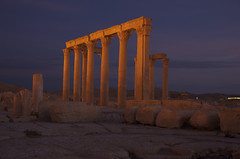On my now officially third-to-last Sunday in London today, I went on my last London walk. The last weekend will be filled with the packing of moving boxes and the shifting of the chunky stuff I haven't been able to sell or freecycle. (Anyone in need of a sofa?) By the end of it, I might collapse, but the flat will be empty and clean, ready to be handed over the next day when also, if everything goes according to plan, my boxes will be picked up and shipped out. Next weekend I'll meet with friends to say good-bye. So today was the last walk.
Initially I had planned to go from Limehouse by the Thames to the Olympic Park because I like the area along the Lee navigation, with the locks and the mill and the canal intertwined with the tidal river. When the sun's out, this is a blissful walk, out in what feels like the countryside (shaped to serve the city) but with the towers of Canary Wharf looming close. For some reason, I went to Greenwich instead. There was no excuse; the tube was running just fine. I think what took me to Greenwich was the chance to see something new while at the same time saying good-bye to an area I've visited so many times.
Royal Greenwich is famous for the zero meridian and the observatory where accurate global time keeping was developed. The observatory sits on the high point of a lovely park, a proper English garden. At its foot is the Maritime Museum, free and recently expanded, and the Old Naval College. Then there's the tea clipper Cutty Sark, badly damaged in a fire a few years back but since restored and now floating on a glass pedestal, with a café underneath. There's so much to see and do, one afternoon doesn't do it justice. In my years in London, I've gone to the observatory half a dozen times. The story of marine chronometry is too fascinating and between visits, I always forget the details.
Today, I didn't stray from town though. After a quick diversion across the market, posh and wholesome, with organic sausages next to vegan raw food, with hand painted t-shirts and cosmetics made with "no noxious chemicals" at all, I gave in to my fondness for murky waters. I dropped down to the river where the tide ran high. My walk began here, on the Thames Path, heading downriver.
By some measure, I was circling the Isle of Dogs. To my left, across the heavy river, rose the steel and glass of condominium complexes and the skyscraping headquarters of financial institutions. Traces of industry and trade have largely been obliterated. Heritage is provided involuntarily, by council housing built in the dirty bricks of a grim past, but it's dwarfed by the storage facilities of international property investors' wealth, i.e. shiny flats lying empty. This doesn't interest me much.
It was good then that by another measure, and by my intention, I was circling the Greenwich peninsula. To my right, in touching distance, were what was left of decades of shipbuilding, gun making, oil milling and the twining of submarine cables. The site had been so successful that no one asked about consequences. Men came home black and the earth and water died, but negative externalities were considered academic curiosities. When most factories closed in the 60s and 70s, a wasteland remained. Environmental regeneration and economic redevelopment has been ongoing for nearly 20 years.
It was a cold and grey day, and the path was often muddy. I had walked to North Greenwich three years ago and much of the abandoned industrial structures that I saw back then are now gone. It was quite striking. Lots of housing developments under construction and more where they've just broken ground. The Amylum starch refinery, which was quite imposing three years ago, is now completely gone. This place will be unrecognizable in another three to five years, unless a meltdown of the London property market kills off these projects.
The part down the river from North Greenwich was new to me. This being the other side of the same peninsula, it was more of the same – barbed-wire fences and rotting hoardings, tumble-down sheds of mysterious purpose and construction sites displacing ruined industry. I was quite elated by the beauty. On the other side of the river was now the massive Tate & Lyle factory with its slightly desperate "Save Our Sugar" banner, which demands, on an acre of tarp hanging off the side of the office building, "a fair deal for cane refiners".
I passed the Thames Barrier, which I have still not seen in action, and continued towards Woolwich. Here I was on familiar ground again, having dragged my mom along this section many years ago. The warehouses, repair shops and fading industrial ventures looked unchanged. Back then we crossed underneath the Thames in the Woolwich foot tunnel, which is much longer than its Greenwich counterpart and rather spooky. This time I came to take the ferry.
The ferry runs above the tunnel, connecting the same points on either side of the river. That may sound superfluous, but the ferry carries cars as well as people. It's kept alive by a perennial lack of infrastructure funding. There are no bridges east of London, except the motorway, which is a toll road. The ferry is free. The top deck quickly filled with cars, but the passenger space downstairs remained empty. The ride across took less than ten minutes. I had forgotten how unimaginably grim the other side was, run down, deprived, too sad even for me. I hurried to King George V, hopped in a DLR for possibly the last time, and rode back home.
